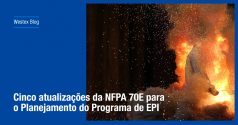Aprenda como proteger melhor sua força de trabalho com a vestimenta antichama apropriada para cada região.
A pandemia global trouxe muitas coisas antes não observadas pela população em geral, incluindo um maior interesse e compreensão sobre os equipamentos de proteção individual (EPI). O cenário de EPI’s tem sido parte integrante dos programas de segurança do trabalho por décadas para os profissionais responsáveis por equipar a sua força de trabalho em atividades que envolvam riscos. Mas o fato de você saber que os EPI’s vão muito além das máscaras faciais não faz com que o processo de seleção seja mais fácil. Adicione a isso as complexidades de uma força de trabalho em diferentes países e terá uma tarefa ainda mais desafiadora.
1. Comece com uma boa avaliação dos riscos
O primeiro ponto a lembrar ao assumir a responsabilidade de garantir que as equipes em vários países tenham vestimentas de proteção térmica FR / AR adequadas é a necessidade de uma abordagem por país . Considerar normas e leis específicas de cada região é o primeiro passo neste sentido. Você pode começar informando-se com organizações locais de saúde e segurança para obter orientação sobre como implementar uma avaliação de riscos em suas operações.
Depois de fazer as avaliações de riscos com uma abordagem local você pode economizar tempo contando com um fornecedor de tecidos que tenha experiência em implementação em vários países, contribuindo com seu processo de seleção de vestimenta para cada região. Os parceiros locais, como confeccionistas, irão ajudar na personalização e customização final para uma total aderência do seu programa.
2. Peça ajuda
É fácil se confundir com uma sopa de siglas – ASTM, NFPA, IEC, IRAM, ABNT, NMX dentre outras. Mas qual é a melhor maneira de entender claramente o que cada sigla significa? Faça perguntas, muitas perguntas. Um parceiro global como a Westex pode explicar o papel de cada organismo de normas e legislação envolvidos neste processo. Nossa equipe está pronta para lhe ajudar a entender quais tecidos atenderão aos vários riscos que a sua força de trabalho enfrentará e a norma de proteção adequada para cada região.
Nossa equipe possui qualificação para orientar as empresas nas normas específicas que devem ser cumpridas e, além disso, adicionar informações como qual será a melhor tecnologia têxtil para o tipo de clima que sua força de trabalho estará sujeita.
3. Pense no processo como um todo
O EPI ideal é projetado para que o trabalhador o utilize. Portanto, embora a análise de riscos e as normas de segurança sejam essenciais para a tomada de decisão, é importante também iniciar seu processo pensando em cada fator que sua força de trabalho enfrentará.
Veja o clima, por exemplo. Uma vestimenta que pode funcionar bem em climas mais frios pode não ser confortável em climas mais quentes. Pergunte-se: em que apectos as tarefas realizadas em várias regiões são diferentes? Que fatores ambientais os trabalhadores de cada região estarão sujeitos? Um local requer uma vestimenta que seja mais leve e facilite a movimentação do trabalhador?
Ao alocar tempo para auditar os principais fatores em cada região você terá elementos para construir um melhor programa de vestimentas de proteção, um componente-chave para manter seus colaboradores seguros.
4. Agilize o processo
Ao escolher um parceiro global como a Westex você terá acesso aos gerentes que se dedicam a várias regiões, garantindo um contato pessoal que trará mais visibilidade aos requisitos de cada região. Além disso, os avanços digitais tornaram mais fácil este contato com nossas equipes globais.
Ao projetar um programa de vestimentas em nível global, lembre-se de que este processo é mais parecido com uma maratona e não uma prova de 100 metros rasos. Planejar este processo avaliando os vários cenários em que sua equipe está trabalhando para estruturar um levantamento criterioso das diferentes normas e condições poderá fazer com que você economize tempo, recursos e potencialmente crie uma melhor relação custo-benefício a longo prazo.
Artigo escrito por Paul Castelli, diretor internacional de vendas e adapatado por Maria Chies, gerente de mercado para América Latina.
Ambos da Westex: A Milliken Brand.










